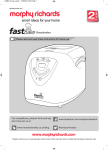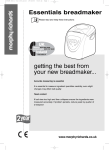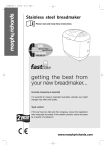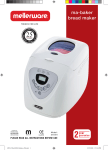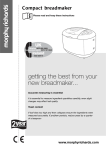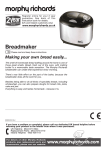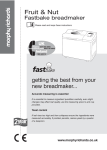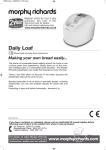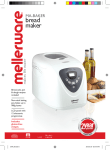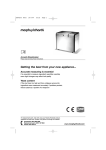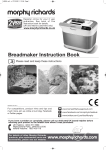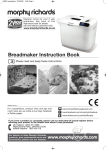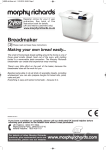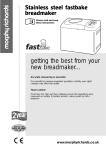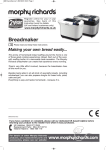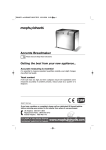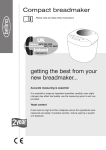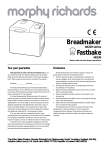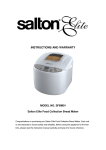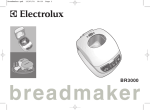Download Morphy Richards RAPID COOK Operating instructions
Transcript
48280 rev4:x 13/11/2009 11:12 Page 1 Upon registration with Morphy Richards (UK & ROI only) Register online for your 2 year guarantee. See back of this instruction book for details. (UK and Ireland customers only) www.morphyrichards.co.uk Fastbake Breadmaker Please read and keep these instructions Getting the best from your new breadmaker... Accurate measuring is essential It is essential to measure ingredient quantities carefully, even slight changes may effect loaf quality. Yeast content If loaf rises too high and then collapses ensure the ingredients were measured accurately. If problem persists, reduce yeast by half a teaspoon. BM48280 MUK Rev4 If you have a problem or complaint, please call our dedicated UK based helpline before returning your product to the retailer from where it was purchased. UK Helpline: 0844 871 0944 Replacement Parts: 0844 873 0710 Ireland Helpline: 1800 409 119 48280 rev4:x 13/11/2009 11:12 Page 2 IMPORTANT SAFETY INSTRUCTIONS The use of any electrical appliance requires the following common sense safety rules. Primarily there is danger of injury or death and secondly the danger of damage to the appliance. These are indicated in the text by the following two conventions: WARNING: Danger to the person! IMPORTANT: Damage to the appliance! In addition, we offer the following safety advice. Location • This appliance is intended to be used in household and similar applications such as: • Do not let the cable run across an open space e.g. between a low socket and table. • Do not let the cable run across a cooker or toaster or other hot area which might damage the cable. • If the supply cable is damaged, it must be replaced by the manufacturer, it’s service agent or similarly qualified persons in order to avoid a hazard. Personal safety • WARNING: To protect against fire, electric shock and personal injury, do not immerse cord, plug and appliance in water or any other liquid. • WARNING: Do not touch hot surfaces. Use oven mitts or oven gloves when removing the hot bread pan. Do not cover the steam vent openings under any circumstances. farm houses; by clients in hotels, motels and other residential type environments; bed and breakfast type environments. It is not suitable for use in staff kitchen areas in shops, offices and other working environments. • Always locate your appliance away from the edge of a worktop. • Ensure that the appliance is used on a firm, flat surface. • Do not use the appliance outdoors, or near water. Mains cable • The mains cable should reach from the socket to the base unit without straining the connections. • WARNING: Avoid contact with moving parts. Children • Never allow a child to operate this appliance. • Children are vulnerable in the kitchen, particularly when unsupervised and if appliances are being used or cooking is being carried out. • Teach children to be aware of dangers in the kitchen, warn them of the dangers of reaching up to areas where they cannot see properly or should not be reaching. • Children should be supervised to ensure that they do not play with the appliance. Treating scalds • Run cold water over the affected area immediately. Do not stop to remove clothing, get medical help quickly. Other safety considerations • Extreme caution must be observed when moving an appliance with hot contents. • If the mains lead of this appliance is damaged do not use it. The lead may only be replaced by Morphy Richards Ltd or an agent of the company, since special purpose tools are required. Telephone Morphy Richards helpline for advice. • Do not use breadmaker for storage purposes nor insert any utensils, as they may create a fire or electric shock hazard. • The use of accessory attachments not recommended by the manufacturer may cause damage to the breadmaker. • Do not use the appliance with wet or moist hands. • Do not place the appliance on or near heat sources such as gas or electric stove ovens, or burners. • To protect against electrical shock, do not immerse cord or plug in water or other liquid. • This appliance is not intended for use by persons (including children) with reduced physical, sensory or mental capabilities, or lack of experience and knowledge, unless they have been given supervision or instruction concerning the use of the appliance by a person responsible for their safety. • To avoid damaging the appliance, do not place the baking pan or any object on top of the unit. • Do not clean with scouring pads. Do not wash the baking pan, kneading blade measuring cup or spoon in a dishwasher. • Do not let the mains cable hang over the edge of a worktop where a child could reach it. 2 UK Helpline 0844 871 0944 Replacement Parts 0844 873 0710 Ireland Helpline 1800 409 119 48280 rev4:x 13/11/2009 11:12 Page 3 • Keep the appliance and the cable away from heat, direct sunlight, moisture, sharp edges and the like. • This appliance is not intended to be operated by means of an external timer or separate remote control system. • The baking pan must be in place prior to switching on the appliance. • Always remove the plug from the socket whenever the machine is not in use, when attaching accessory parts, cleaning the machine or whenever a disturbance occurs. Pull on the plug, not the cable. ELECTRICAL REQUIREMENTS Check that the voltage on the rating plate of your appliance corresponds with your house electricity supply which must be A.C. (Alternating Current). Operating Instructions Safety instructions 2 Electrical requirements 3 Introduction 4 Before first use 4 About this breadmaker 4 About the recipes 4 Features 4 Control panels buttons, display and functions 5 Programme descriptions 5 Using your breadmaker 6 Using the timer 7 Beeper 7 Power interruption 7 Slicing and storing bread 7 Care and cleaning 7 Storing the unit 8 Know your ingredients 8 Measuring ingredients 9 Ingredient temperatures 10 Creating your own yeast breads 9 Special glazes for yeast breads 10 Other tips 10 If the socket outlets in your home are not suitable for the plug supplied with this appliance, the plug should be removed and the appropriate one fitted. Note: The plug removed from the mains cable, if severed, must be destroyed as a plug with bared flexible cord is hazardous if engaged into a live socket outlet. WARNING: THIS APPLIANCE MUST BE EARTHED. Should the fuse in the 13 amp plug require changing a 13 amp BS1362 fuse must be fitted. Recipes Basic breads Basic white bread Softgrain bread Brown loaf Italian herb bread Cheese & onion bread Raisin bread Sun-dried tomato loaf Malt loaf French bread 11 11 11 11 11 11 11 11 12 Wholewheat breads Wholewheat bread Granary loaf 12 12 Quick setting Banana and nut bread Porridge oats bread 12 12 Sweet Mixed fruit loaf Chocolate bread 12 12 Fastbake I Fastbake small white 13 Fastbake II Fastbake large white 13 Dough recipes White bread rolls Wholewheat bread rolls Hot cross buns Pizza base 13 13 13 13 Jams Marmalade Raspberry and apple 14 14 Cake recipes Standard cake mix Mixed fruit cake 14 14 Sandwich Sandwich loaf Softgrain sandwich loaf 14 14 Further Information Baking cycle times Conversion tables Need help? Questions and answers Troubleshooting For details of other Morphy Richards products, please see our website: 15 16 17 18 33 48280 rev4:x 13/11/2009 11:12 Page 4 INTRODUCTION The smell of homemade bread wafting around the home is one of those great smells. Bread, fresh out of the oven, with melting butter is a memorable taste sensation. The Morphy Richards automatic breadmaker can create that experience every morning. There's very little effort on the part of the baker, because the breadmaker is a sophisticated appliance with a computer memory that does all the work for you. It’s as simple as one-two-three. 1 Put in the ingredients. 2 Select program from the menus and press start. 3 Wait for your bread. But don't stop at baking bread in this appliance. Besides being able to do all kinds of speciality breads, including wholewheat, you can also prepare doughs for bread rolls, pizza, cake and jam. Everything is easy and tastes homemade - because it is. Before First Use Before first use, please take a few minutes to read this instruction book and to find a place to keep it handy for reference. Pay particular attention to the safety instructions. 1 Carefully unpack the breadmaker and remove all packaging materials. 2 Remove any dust that may have accumulated during packing. 3 Wipe the baking pan, kneading blade and outside surface of the breadmaker with a clean, damp cloth. The bread pan is non-stick coated. Do not use scouring pads or any abrasives on any part of the breadmaker. 4 For first time use oil, butter or margarine to grease the bread pan and bake empty for about 10 minutes (select the Extrabake program). FEATURES ⁄ Air vents ¤ Viewing window ‹ Lid handle › Cover fi Control Panel fl Main body ‡ Handle 5 Clean once more. · Baking Pan 6 Place the kneading blade on the axle in the baking pan. ‚ Kneading blade In manufacture it is necessary to lightly grease some parts of the appliance. This may result in the unit emitting some vapour when first used, this is normal. About This Breadmaker „ Rotating shaft Display Window Shows browning level selected, Shows weight selected, Shows the program number, Shows time left before completion (3:20, for example, is 3 hours and 20 minutes; 0:20 is 20 minutes,) Shows the temperature warning - see ‘Troubleshooting’ • It has two settings to make a small 680g (1.5lb) or large 907g (2lb) loaf (approx weight depends on recipe). Timer delay buttons Use to delay the start of bread making (all programs except Fastbake). • A Fruit and Nut beep signals when extra ingredients can be added so they don’t get chopped by the kneading blade. Start Press to start for approx 1 second, a beep sounds and the colon (:) flashes and the program starts. • The 1.5lb setting can be used to make a 1lb loaf for some of the recipes. Stop Press to stop for approx 2 seconds, a beep sounds to confirm. About the Recipes The recipes in this booklet have been thoroughly tested to ensure best results. Recipes have been created by home economists specifically for this machine and may not produce acceptable results in other similar machines. • Always add ingredients in the order they are listed in the recipe. Colour button For selecting crust colour from light, medium or dark (certain programs only) Menu button For choosing the bread making program from the list 1 to 12 Loaf size button For selecting small (1.5lb) or large (2lb) loaf size (certain programs only). • Accurate measuring of ingredients is vital. Do not use larger amounts. 4 UK Helpline 0844 871 0944 Replacement Parts 0844 873 0710 Ireland Helpline 1800 409 119 48280 rev4:x 13/11/2009 11:12 Page 5 ⁄ ¤ › ‡ ‹ fi · ‚ „ fl Program Descriptions 1 Basic white (3:00 and 2:53) For white and brown bread. Also for flavoured breads with added herbs and raisin. 1 2 3 4 Basic white French Wholewheat Quick 2 French (3:50 and 3:40) For the baking of light weight bread such as french bread which has a crisper crust and light texture. 5 6 7 8 Sweet 9 Jam Fastbake I Fastbake II 10 Cake 11 Sandwich Dough 12 Extrabake co u en m e 6 Fastbake I (0:58) For preparation of a 1.5lb white loaf in a reduced time period. Loaves made on this setting can be shorter and the texture more moist. tim 5 Sweet (2:55 and 2:50) For the baking of sweet type bread which gives a crisper crust than on basic setting. The crisper crust is produced by the sugar ‘burning’. e 4 Quick (1:40) For white bread that is required in a shorter time. Bread baked on this setting is usually smaller with a dense texture. tim 3 Wholewheat (3:40 and 3:32) For the baking of bread containing significant amounts of wholewheat. This setting has longer preheat time to allow the grain to soak up the water and expand. It is not advised to use the delay timer as this can produce poor results. lou r Light Medium Dark 1.5lb 2lb loaf size start stop 7 Fastbake II (0:58) For preparation of a 2lb white loaf in a reduced time period. Loaves made on this setting can be shorter and the texture more moist. 8 Dough (1:30) This setting only makes the dough and will not bake the final bread. Remove the dough and shape it to make bread rolls, pizza, etc. Any dough can be prepared on this setting. Do not exceed 1kg (2lb) of combined ingredients. 9 Jam (1:20) Use this setting for making jam from fresh fruits and marmalade from Seville oranges. Do not increase the quantity or allow the recipe to boil over the pan into the baking chamber. Should this happen, stop the machine immediately. Remove the pan carefully, allow to cool a little and clean thoroughly. For details of other Morphy Richards products, please see our website: 5 48280 rev4:x 13/11/2009 11:12 Page 6 10 Cake (2:50) This setting will mix ingredients and then bake for a preset time. It is required to mix two groups of ingredients in bowls before adding to the breadmaker (see cake recipes). 11 Sandwich (3:00 and 2:55) This is to bake light texture bread but with a softer but thicker crust. 12 Extra bake (1:00) This setting is bake only and can be used to increase the baking time on selected settings. This is especially useful to help ‘set’ jams and marmalade. When started the default time is 1 hour (1:00) minimum and counts down in 10 minute intervals. You will have to manually switch this off by pressing the stop button, when you have completed the Extrabake process. It is advised that you check the condition of the bread or jam after 10 minutes and at 10 minute intervals. Pressing ▲ increases the time in increments of 10 minutes. When selecting Extrabake straight after another program, if the message H:HH is displayed, open the lid, remove the pan and allow to cool for 10 minutes. When cool, replace the baking pan and its contents, set program and press start. USING YOUR BREADMAKER 1 Take out the pan Open the lid and remove the pan by lifting the handle, turning anti-clockwise and lifting out. Place on the work surface. It is important that the pan is filled with ingredients outside the machine so that any accidental spillage is not ignited by the heating elements. 2 Attach the blade Attach the kneading blade to the shaft by pushing on. 6 UK Helpline 0844 871 0944 3 Measure ingredients Measure the ingredients required and add them all into the pan in the order listed. (See later section ‘Measuring your ingredients’). • When adding the yeast to the baking pan, take care that the yeast does not come into contact with the water or any other liquid, as it will start to activate immediately. • Use tepid water 21-28ºC. 4 Put pan back in Place the baking pan back in the breadmaker, turning clockwise to lock into place. Close the lid. 5 Plug in Plug into the power supply. The breadmaker will automatically be set to basic bread menu and normal time. • Every time you press a button you will hear a beep to confirm. 6 Select programme Choose the desired setting from the list by pressing the Menu button. 7 Select weight Press Loaf size button to choose between small or large. 8 Select colour Choose desired crust colour by pressing Colour button. 9 Select the delay time If you wish the bread to be ready later, set the time delay now, as described in next section. 10 Start Press the Start Stop button to start the machine. The remaining time will count down in one minute increments. 11 Progress The breadmaker will automatically proceed through the programmed stages as shown in the ‘Baking cycle times’ section. If the breadmaker has a program selected that has a second kneading process, beeps Replacement Parts 0844 873 0710 sound to inform that fruits and/or nuts may be added. • It is possible that steam will escape through the vents during baking, this is normal. 12 Finish When the programme is completed and the bread is baked the display shows 0:00 and the beeper will sound. 13 Keep warm The keep warm function will circulate hot air for a further 60 minutes on most settings (see ‘Baking cycle times’ section). For best results, remove the baking pan and loaf within this period or when the initial program is completed. 10 beeps will be heard when the keep warm period is finished. 14 Remove the food Press Stop. Open the lid. WARNING: Use oven gloves when removing the baking pan (taking care as it is very hot). 15 Turn out the bread Allow the bread to cool in the pan for 15 minutes, then turn the pan upside down and tap the bread from the pan onto a rack to cool. Fill the pan with warm water immediately to prevent the blade from sticking to the shaft. • Occasionally the kneading blade will stay in the loaf. Wait until the loaf is cool and then remove the blade with a wooden or plastic utensil to avoid damage to the non-stick surface. 16 Always unplug the appliance after use. • Do not open the lid whilst the breadmaker is operating as this will affect the quality of the bread, especially its ability to rise properly. Only open the lid when the recipe needs you to add additional ingredients, see recipes. Ireland Helpline 1800 409 119 48280 rev4:x 13/11/2009 11:12 Page 7 Room temperature note The breadmaker will work well in a wide range of temperatures, but there could be a difference in loaf size between a very warm room and a very cold room. We recommend the room temperature should be between 15ºC and 34ºC. Using the timer Use the timer when you want the bread ready later, or in the morning. A maximum of 13 hours can be set. Check if function is available by consulting ‘Baking cycle times’ section. Do not use this function with recipes that use perishable ingredients such as eggs, fresh milk, sour cream, or cheese. 1 Decide when you want the bread to be ready and calculate the difference in time between now and then. For example, if you want a loaf at 8am, and it is now 7.30pm, the difference is 12 1/2 hours. 2 Enter this time by pressing ‘Time▼’ and ‘Time▲’ buttons. Arrows will move time up or down in 10 minute increments. After you have pressed Start, the colon (:) will flash. • If you have selected the wrong time press stop for 2 seconds. The timer will go back to the program time, repeat step 1 and 2. 3 The timer delay is up to a maximum of 13 hours. This is when the bread will be ready to remove from the machine, see page 6 item 14 ‘Remove the food’. Beeper The beeper sounds: • When pressing any button; • During the second kneading cycle of certain programs to indicate that cereals, fruit, nuts or other ingredients can be added; Care and cleaning • When the program finishes; • When keep warm finishes. Power Interruption After a brief power supply failure: • If the programme has not yet reached rise 1, press Start and the program will continue using the automatic repeat function; • If it has gone beyond this point, the process must be started from the very beginning. The ingredients will have to be discarded and you must start again with fresh ingredients. Slicing and storing bread For best results place bread on a wire rack and allow to cool for 15-30 minutes before slicing. Use an electric knife or a sharp knife with a serrated blade for even slices. Store unused bread tightly covered in a plastic bag at room temperature for up to three days. If weather is hot and humid, store in the refrigerator overnight. For longer storage (up to one month), place bread in a tightly covered container in the freezer. If you store the bread in the refrigerator, leave it out to bring it to room temperature before serving. 1 Caution: To prevent electrical shock, unplug the unit before cleaning. 2 Wait until the breadmaker has cooled. • IMPORTANT: Do not immerse or splash either the body or lid in any liquid as this may cause damage and/or electric shock. 3 Exterior: Wipe the lid and outer body of the unit with a damp cloth or slightly dampened sponge. 4 Interior: Use a damp cloth or sponge to wipe the interior of the breadmaker. 5 Baking pan: Clean the baking pan with warm water, soap is not necessary. Avoid scratching the non-stick surface. Dry it thoroughly before placing it back in the baking chamber. • Do not wash the baking pan, measuring cup, spoon or kneading blades in the dishwasher. • Do not soak the baking pan for long periods as this could interfere with the working of the drive shaft. • If the paddle becomes stuck in the bread pan, pour hot water over it and allow to soak for 30 minutes. This will enable you to remove the paddle more easily. • Be sure the appliance is completely cooled before storing away. Do not use any of these when cleaning: Since homemade bread has no preservatives it tends to dry out and become stale faster than commercially made bread. • Paint thinner Leftover slightly hardened bread may be cut into 1.3 cm (half inch) or 2.5cm (1 inch) cubes and used in favourite recipes to make croutons, bread pudding, or stuffing. • Polishing powder • Benzine • Steel wool pads • Chemical dust cloth For details of other Morphy Richards products, please see our website: 7 48280 rev4:x 13/11/2009 11:12 Page 8 Special care for the non-stick finish Avoid damaging the coating. Do not use metal utensils such as spatulas, knives or forks. The coating may change colour after long use, this is only caused by moisture and steam and will not affect the performance of the unit or quality of your bread. The hole in the centre of the kneading blade should be cleaned, then add a drop of cooking oil and replace it on the spindle in the baking pan. This will prevent sticking of the blade. • Keep all air vents and openings clear of dust. Storing the unit Be sure to dry all parts before storing including wiping any moisture from the viewing window. Close the lid and do not store anything on top of the lid. UNDERSTANDING BAKING It is often said that cooking is an art relying on the creativity of the chef while baking bread is much more of a science. This means that the process of combining flour, water and yeast results in a reaction that produces bread. You have to remember that when the ingredients combine with each other they produce a specific result. Read the following information carefully to gain a better understanding of the importance each ingredient plays in the breadmaking process. Important note on flours Flours, while visibly similar, can be very different by virtue of how they were grown, milled, stored, etc. You may find that you will have to experiment with different brands of flour to help you make that perfect 8 UK Helpline 0844 871 0944 loaf. Storage is also very important, as all flours should be kept in an airtight container. All purpose flour/plain flour All purpose flour is a blend of refined hard and soft wheat flours especially suitable for making cake. This type of flour should be used for recipes in the cake/quick bread section. Strong white flour/bread flour Bread flour is a high gluten/protein flour that has been treated with conditioners that give dough a greater suitability for kneading. Bread flour typically has a higher gluten concentration than All purpose flour; however, depending on different milling practices, this may vary. Strong plain flour or bread flour are recommended for use with this breadmaker. Whole wheat flour/ wholemeal flour Whole wheat flour/wholemeal flour is milled from the entire wheat kernel which contains the bran and germ and makes it heavier and richer in nutrients than white flour. Breads made with this flour are usually smaller and heavier than white loaves. To overcome this whole wheat flour/wholemeal flour can be mixed with Bread flour or strong plain flour to produce a high light textured bread. Self-raising flour Self-raising flour contains unnecessary leavening ingredients that will interfere with bread and cake making. It is not recommended for use. Bran Bran (unprocessed) & Wheat Germ are the coarse outer portions of the wheat or rye grains separated from flour by sifting or bolting. They are often added in small quantities to bread for nutritional enrichment, heartiness and flavour. They are also used to enhance the texture of bread. Replacement Parts 0844 873 0710 Oatmeal Oatmeal comes from rolled or steel-cut oats. They are used primarily to enhance flavour and texture. Other ingredients Yeasts (active dry yeast) Yeast through a fermentation process produces gas (carbon dioxide) necessary to make the bread rise. Yeast must be able to feed on sugar and flour carbohydrates in order to produce this gas. Fast action granular yeast is used in all recipes that call for yeast. There are basically three different types of yeast available, fresh, traditional dry active and fast action. It is recommended that fast action yeast be used. Fresh or compressed cake yeast is not recommended as they will produce poor results. Store yeast according to manufacturers instructions. Ensure your yeast is fresh by checking its expiration date. Once a package or can of yeast is opened it is important that the remaining contents be immediately resealed and refrigerated as soon as possible for future use. Often bread or dough, which fails to rise is due to stale yeast being used. The following test can be used to determine whether your yeast is stale and inactive: 1 Place half a cup of lukewarm water into a small bowl or cup. 2 Stir 1 tsp. of sugar into the water then sprinkle 2 tsp. of yeast over the surface. 3 Place bowl or cup in a warm area and allow to sit for 10 minutes undisturbed. 4 The mixture should foam and produce a strong yeast aroma. If this does not occur, discard mixture and start again with another packet of dried yeast. Sugar Sugar is important for the colour and flavour of breads. It is also food for the yeast as it is part of the fermentation Ireland Helpline 1800 409 119 48280 rev4:x 13/11/2009 11:12 Page 9 process. Artificial sweeteners cannot be used as a substitute for sugar as the yeast will not react properly with them. Salt Salt is necessary to balance the flavour of breads and cakes, as well as for the crust colour that develops during baking. Salt also limits the growth of yeast so the amounts shown in the recipes should not be increased. For dietary reasons it may be reduced, however, your baking may suffer. Liquids/milk Liquids such as milk or a combination of powdered milk and water, can be used when making bread. Milk will improve flavour, provide a velvety texture and soften the crust, while water alone will produce a crispier crust. Some liquids call for juice (orange, apple, etc) to be added as a flavour enhancer. Note: For most recipes we suggest the use of dry skimmed milk. Eggs Eggs add richness and a velvety texture to bread doughs and cakes. Sunflower oil ‘Shortens’ or tenderises the texture of yeast breads. Butter or margarine can be used as a substitute. If butter or margarine is used direct from the refrigerator it should be softened for easier blending during the mixing cycle. Baking powder Baking powder is a raising agent used in cakes. This type of raising agent does not require rising time before baking as the chemical reaction works when liquid ingredients are added. Bicarbonate of soda Bicarbonate of soda is another raising agent not to be confused or substituted for baking powder. It also does not require rising time before baking as the chemical reaction works during the baking process. Measuring Ingredients The key and most important step when using your breadmaker is measuring your ingredients precisely and accurately. It is extremely important to measure each liquid and dry ingredient properly or it could result in a poor or unacceptable baking result. The ingredients must also be added into the baking pan in the order in which they are given in each recipe. Liquid and dry measurements are done somewhat differently and are as follows: A B B Liquid measurements Use the cup provided A. When reading amounts, the measuring cup must be placed on a horizontal flat surface and viewed at eye level (not on an angle). The liquid level line must be aligned to the mark of measurement. A ‘guesstimate’ is not good enough as it could throw out the critical balance of the recipe. Dry measurements Dry measurements (especially flours) must be done using the measuring cup provided. The measuring cup is based on the American standard 8 fluid oz cup - British cup is 10 fluid oz. Dry measuring must be done by gently spooning ingredients into the measuring cup and then once filled, levelling off with a knife. Scooping or tapping a measuring cup will pack the ingredients and you will end up with more than is required. This extra amount could affect the balance of the recipe. Do not sift the flour, unless stated. When measuring small amounts of dry or liquid ingredients (ie yeast, sugar, salt, powdered milk, honey, molasses) the measuring spoon which is provided must be used. Measurements must be level, not heaped as this small difference could throw out the critical balance of the recipe B. For details of other Morphy Richards products, please see our website: Your breadmaker produces delicious baked goods with ease. This machine requires only that you carefully follow the recipe instructions. In basic cooking, normally ‘a pinch of this and a dash of that’ is fine, but not for breadmakers. Using an automatic breadmaker requires you accurately measure each ingredient for best results. Ingredient Temperatures All ingredients, including the machine and pan, and especially liquids (water or milk), should be warmed to room temperature 21°C (70°F). If ingredients are too cold, below 10°C (50°F), they will not activate the yeast. Extremely hot liquids, above 40°C (104°F), may kill the yeast. Creating your own yeast breads With the breadmaker, even the most inexperienced baker can achieve the satisfying experience of baking a loaf of bread. All of the mystery and hard work is gone. Inside this talented machine with an 9 48280 rev4:x 13/11/2009 11:12 Page 10 electronic brain, the dough is mixed, kneaded, proofed and baked without you being present. The automatic breadmaker can also just prepare the dough, and when it's ready, you shape, allow to rise and bake in a conventional oven. The recipes on the following pages are ‘tailored’ for this breadmaker. Each recipe features ingredients that best compliment a particular loaf of bread, and each was tested in our machines. It is extremely important not to exceed the amounts of flour specified in each of the recipes or else it could result in unsatisfactory baking performance. When creating your own yeast bread recipes or baking an old favourite, use the recipes in this cookbook as a guide for converting portions from your recipe to your breadmaker. Special glazes for yeast breads Give your just baked bread a professional finish. Select one of the following special glazes to enhance your bread. Egg glaze Beat 1 large egg and 1 tablespoon of water together, brush generously. Note: apply only to doughs before baking. Melted butter crust Brush melted butter over just baked bread for a softer, tender crust. Milk glaze For a softer, shiny crust, brush just baked bread with milk or cream. Sweet icing glaze Mix 1 cup sifted icing sugar with 1 to 2 tablespoons of milk to make a glaze consistency and drizzle over raisin bread or sweet breads. Poppy/Sesame/Caraway seed/Oatmeal Sprinkle your choice of these seeds generously over just glazed bread. 10 UK Helpline 0844 871 0944 Other tips • Place all recipe ingredients into the baking pan so that yeast is not touching any liquid. • After completing the process of making dough in your breadmaker, typically when letting dough rise outside the breadmaker, allow 30 minutes or until dough doubles in size. Dough should be lightly greased and covered with grease proof paper and a dry towel. It should be placed in a warm area free from draughts. • Humidity can cause problems, therefore humidity and high altitudes require adjustments. For high humidity, add an extra tablespoon of flour if consistency is not right. For high altitudes, decrease yeast amount by approximately 1/4 teaspoon, and decrease sugar and/or water or milk slightly. • The DOUGH setting is great for the mixing, kneading and proofing (allowing dough to rise) richer doughs like croissant dough. Use the automatic breadmaker to prepare this dough so all you need to do is shape and bake it according to your recipe. • When recipes call for a ‘lightly floured surface,’ use about 1 to 2 tablespoons of flour on the surface. You may want to lightly flour your fingers or rolling pin for easy dough manipulation. • After 5 minutes of kneading, open the lid and check the dough consistency. The dough should form a soft, smooth ball. If too dry, add liquid. If too wet, add flour (1/2 to 1 tablespoon at a time). RECIPES All of the following recipes use this same general method: 1 Measure ingredients into baking pan. 2 Use tepid water 21-28ºC. 3 Insert baking pan securely into unit, close lid. 4 Select appropriate bread setting. 5 Push start button. 6 When bread is done, remove pan from unit using oven mitts. 7 Remove bread from baking pan, (and kneading blade from bread if necessary). 8 Allow to cool before slicing. This method is modified by notes, if applicable, at the end of each recipe. These recipes have been developed using Allinson flours and Easybake Allinson yeast. • When you let dough ‘rest’ and ‘rise’ according to a recipe, place it in a warm, draught-free area. If the dough does not double in size, it may not produce a tender product. • If the dough you are rolling shrinks back, let it rest covered for a few minutes before rolling again. • Dough may be wrapped in plastic and stored in a freezer for later use. Bring the dough to room temperature before using. Replacement Parts 0844 873 0710 Ireland Helpline 1800 409 119 48280 rev4:x 13/11/2009 11:12 Page 11 Recipes for basic bread Cheese & onion bread Basic white bread 11⁄2 Ib ⁄4 cup 11⁄8 cup 2 tbsp 21⁄2 tbsp 2 tbsp 21⁄2 tbsp 11⁄4 tbsp 21⁄4 tbsp 1 tsp 11⁄4 tsp 2 cups 3 cups 1 tsp 11⁄4 tsp 1 Basic 1Ib* Water Skimmed milk powder Sunflower Oil Sugar Salt Strong white bread flour Fast action yeast Use Setting 3 2Ib 11⁄2 cup 4 tbsp 4 tbsp 3 tbsp 2 tsp 4 cups 11⁄4 tsp *Use 11⁄2 Ib loaf setting for 1Ib loaf 1 ⁄2 lb 11⁄8 cup 21⁄2 tbsp 21⁄2 tbsp 21⁄4 tbsp 1 1 tsp 2 lb 11⁄2 cup 4 tbsp 4 tbsp 3 tbsp 2 tsp 4 cups 11⁄4 tsp 3 cups 11⁄4 tsp 1 Basic Brown loaf 1 Ib* Water Skimmed milk powder Sunflower Oil Sugar Salt Strong brown bread flour Fast action yeast Use Setting ⁄4 cup 11⁄2 tbsp 11⁄2 tbsp 21⁄2 tbsp 3 1 tsp 2 cup 1 tsp 11⁄2 Ib 1 cup 2 tbsp 2 tbsp 21⁄2 tbsp 11⁄4 tsp 3 cup 11⁄4 tsp 1 Basic 2 Ib 11⁄2 cup 3 tbsp 3 tbsp 4 tbsp 2 tsp 4 cup 11⁄2 tsp *Use 11⁄2Ib loaf setting for 1Ib loaf Italian herb bread Water Skimmed milk powder Sunflower oil Sugar Salt Strong white bread flour Dried marjoram Dried basil Dried thyme Fast action yeast Use setting 11⁄2 Ib 1 cup 2 tbsp 1 tbsp 2 lb 11⁄4 cup 21⁄2 tbsp 2 tbsp 1 ⁄2 tsp 1 tsp 11⁄2 tbsp 2 tbsp 1 cup 11⁄2 cup 3 cup 4 cup 11⁄2 tsp 13⁄4 tsp 1 Basic Raisin bread Softgrain bread Water Skimmed milk powder Sunflower oil Sugar Salt Strong white softgrain bread flour Fast action yeast Use setting Water Skimmed milk powder Sugar Salt Onion granules Mature grated cheddar cheese Strong white bread flour Fast action yeast Use setting 11⁄2 Ib 2 lb 11⁄8 cup 11⁄2 cup 21⁄2 tbsp 3 tbsp 21⁄2 tbsp 3 tbsp 21⁄4 tbsp 21⁄2 tbsp 11⁄2 tsp 2 tsp 3 cups 4 cups 11⁄2 tsp 2 tsp 11⁄2 tsp 2 tsp 11⁄2 tsp 2 tsp 11⁄4 tsp 11⁄2 tsp 1 Basic 11⁄2 Ib 11⁄4 cup 3 tbsp 3 tbsp 2 tbsp 11⁄2 tsp 2 lb Water 11⁄2 cup Skimmed milk powder 4 tbsp Sunflower oil 4 tbsp Sugar 3 tbsp Salt 2 tsp 3 Cinnamon ⁄4 tsp 1 tsp Strong white bread flour 3 cup 4 cup Fast action yeast 11⁄2 tsp 2 tsp 5 Raisins* ⁄8 cup 3⁄4 cup Use setting 1 Basic * Add the fruit when the beeper sounds. Sun-dried tomato loaf Water Skimmed milk powder Sunflower oil Sugar Salt Dried mixed herbs Strong white bread flour Fast action yeast Sun-dried tomatoes Use setting 11⁄2 lb 1 cup 21⁄2 tbsp 21⁄4 tbsp 21⁄4 tbsp 11⁄4 tsp 11⁄2 tsp 3 cup 11⁄4 tsp ⁄8 cup 3 2 lb 11⁄3 cup 3 tbsp 3 tbsp 3 tbsp 11⁄2 tsp 2 tsp 4 cup 11⁄2 tsp ⁄2 cup 1 1 Basic Malt loaf 11⁄2 lb 1 cup 1 tsp 2 tbsp 11⁄2 tbsp 2 tbsp 3 cup 1 tsp 2 lb Water 11⁄4 cup Salt 1 tsp Sunflower oil 3 tbsp Black treacle 21⁄2 tbsp Malt extract 3 tbsp Plain flour 4 cup Fast action yeast 11⁄4 tsp 1 Sultanas* ⁄2 cup 3⁄4 cup Use setting 1 Basic * Add the fruit when the beeper sounds For details of other Morphy Richards products, please see our website: 11 48280 rev4:x 13/11/2009 11:12 Page 12 Ingredients group 2 Plain flour Bicarbonate of soda Baking powder Sugar Salt Use setting Recipes for french bread French bread 1 Ib* 1 ⁄2 Ib 3 Water ⁄4 cup 1 cup Skimmed milk powder 11⁄2 tbsp 2 tbsp 3 Sugar ⁄4 tbsp 1 tbsp Salt 1 tsp 1 tsp Sunflower oil 1 tbsp 1 tbsp Strong white bread flour 2 cup 3 cup Fast action yeast 1 tsp 1 tsp Use setting 2 French *Use 11⁄2 lb loaf size setting for 1 lb loaf 1 2 Ib 11⁄4 cup 21⁄2 tbsp 11⁄4 tbsp 11⁄4 tsp 11⁄2 tbsp 4 cup 11⁄4 tsp Wholewheat bread Strong wholemeal bread flour Fast action yeast Vitamin C tablet (crushed) Use setting 11⁄2 Ib 11⁄8 cup 11⁄2 tbsp 2 tbsp 21⁄2 tbsp 11⁄4 tsp 3 cup ⁄4 tsp 3 ⁄2 tsp ⁄4 tsp 1 ⁄2 cup 1 ⁄4 tsp 1 4 Quick Method Mix group 1 together in a separate bowl. Mix group 2 together in a second bowl. Pour mixture into breadpan. Porridge oats bread Recipes for wholewheat breads Water Skimmed milk powder Sunflower oil Brown sugar Salt 1 2 3 11⁄2 cup 1 2 Ib 15⁄8 cup 3 tbsp 3 tbsp 21⁄2 tbsp 11⁄2 tsp 4 cup ⁄4 tsp 3 1x100mg 1x100mg Milk Eggs (beaten) Sunflower oil Golden syrup Sugar Salt Plain flour Porridge oats Baking powder Bicarbonate of soda Use setting 1 cup 2 egg ⁄2 tsp 1 2 tbsp ⁄4 cup 1 1 tsp 2 cup 1 cup ⁄2 tsp ⁄2 tsp 1 1 4 Quick Sweet Mixed fruit loaf 3 Wholewheat 1 Ib* Granary loaf Water Skimmed milk powder Sunflower oil Soft brown sugar Salt Granary malted brown bread flour Fast action yeast Vitamin C tablet Use setting 11⁄2 Ib 2 Ib 11⁄8 cup 15⁄8 cup 2 tbsp 3 tbsp 2 tbsp 3 tbsp 21⁄2 tbsp 5 tbsp 11⁄4 tsp 2 tsp 3 cup 4 cup 11⁄4 tsp 1 tsp 100mg Recipes for quick setting Banana and nut bread Ingredients group 1 Butter (melted) Milk Mashed banana Egg Walnuts (chopped) Lemon rind 12 UK Helpline 0844 871 0944 100mg 3 Wholewheat 2 tbsp 1 tbsp 1 cup 1 egg ⁄2 cup 1 1 tsp 11⁄2 Ib 11⁄8 cup 21⁄2 tbsp 21⁄2 tbsp 1 ⁄4 cup 11⁄4 tsp 3 cup Water ⁄4 cup Skimmed milk powder 2 tbsp Sunflower oil 2 tbsp Sugar 5 tbsp Salt 1 tsp Strong white bread flour 2 cup 1 Nutmeg ⁄2 tsp 3⁄4 tsp Fast action yeast 1 tsp 11⁄4 tsp 1 Dried mixed fruit † ⁄4 cup 1⁄2 cup Use setting 5 Sweet * Use 11⁄2 lb loaf size setting for 1 lb loaf † Add the fruit when the beeper sounds 3 2 Ib 11⁄3 cup 3 tbsp 3 tbsp 1 ⁄3 cup 11⁄2 tsp 4 cup 1 tsp 11⁄2 tsp ⁄3 cup 2 Chocolate bread Water Egg (beaten) Skimmed milk powder Sunflower oil Sugar Salt Walnuts (chopped) * Strong white bread flour Cocoa powder Replacement Parts 0844 873 0710 11⁄2 Ib 1 cup 1 med 1 tbsp 1 tbsp 2 Ib 11⁄2 cup 1 med 11⁄2 tbsp 11⁄2 tbsp 1 ⁄2 cup ⁄2 tsp 1 ⁄4 cup 21⁄8 cup 1 ⁄2 cup 3 1 1 tsp ⁄4 cup ⁄2 cup 1 3 cup ⁄4 cup 3 Ireland Helpline 1800 409 119 48280 rev4:x 13/11/2009 11:12 Page 13 Fast action yeast 1 tsp 11⁄2 tsp Use setting 5 Sweet * Add the walnuts when the beeper sounds Wholewheat bread rolls Water Skimmed milk powder Butter (melted) Honey Brown sugar Salt Strong wholewheat bread flour Fast action yeast Use setting Recipes for Fastbake I Fastbake small white Water* Strong white bread flour Skimmed milk powder Salt Sugar Sunflower oil Fast action yeast Use setting 270 ml 3 cup 2 tbsp 1 tsp 4 tsp 4 tbsp 3 tsp 6 Fastbake Method Follow method given for white rolls. Hot cross buns Water Butter (melted) Sugar Egg (beaten) Salt Strong white bread flour Recipes for Fastbake II Fastbake large white Water* Strong white bread flour Skimmed milk powder Salt Sugar Sunflower oil Fast action yeast Use setting 360 ml 4 cup 3 tbsp 11⁄2 tsp 5 tsp 5 tbsp 31⁄2 tsp 7 Fastbake 1 *Water measurement is crucial for Fastbake recipes. The ML scale should be used for accuracy. Recipes for dough 1 2 3 4 5 6 3 2 3 4 1 cup ⁄4 cup ⁄4 cup 1 1 1 egg 1 tsp 33⁄4 cup Fast action yeast 2 tsp Cinnamon Nutmeg Raisins Use setting 1 tsp ⁄4 tsp 1 1 cup 8 Dough Method Divide into 8-12 pieces. Shape and flatten slightly. Score a cross on the top of each bun. Glaze with egg and milk (but not the cross). Cover and allow to rise for 30 minutes. Bake in the oven at 190ºC (375°F, gas mark 5) for 16-18 minutes. Pizza base White bread rolls Water Skimmed milk powder Butter melted Sugar Salt Strong white bread flour Fast action yeast Use setting 11⁄4 cup 2 tbsp 2 tbsp 2 tbsp 1 tbsp 11⁄2 tsp 31⁄4 cup 11⁄2 tsp 8 Dough 1 ⁄4 cup 1 tbsp 2 tbsp 2 tbsp 11⁄2 tsp 31⁄4 cup 11⁄2 tsp 8 Dough 1 Method Knead and shape the dough into 6 rolls. Place on a greased baking tray. Brush lightly with melted butter. Cover for 20-25 minutes. Allow to rise until they are double in size and glaze. Bake for approx 15-20 minutes at 190°C (375°F, gas mark 5). Water Butter (melted) Sugar Salt Strong white bread flour Fast action yeast Use setting 1 cup 1 tbsp 2 tbsp 1 tsp 23⁄4 cup 1 tsp 8 Dough Method 1 Pre-heat oven. 2 Shape into a flat round shape. Place on a greased baking tray. Brush lightly with oil. 3 Cover for 15 minutes and allow to rise. 4 Add your desired topping. 5 Bake at approx 200ºC (400°F, gas mark 6) until golden brown. For details of other Morphy Richards products, please see our website: 13 48280 rev4:x 13/11/2009 11:12 Page 14 Recipes for jams Marmalade Juice from oranges Rind of oranges Preserving sugar Water Pectin if needed Use setting 3 medium 2 grated 1 cup 1 tbsp 2 tsp 9 Jam Comments • Warm the jars before filling. • Use extra bake time if needed according to set of the marmalade and the size of the oranges. • Remove the paddle with tongs before pouring the marmalade into the jars. • Do not lift the lid during mixing. • Seville oranges should be used for marmalade but are only available in January. If using other oranges pectin will be needed to firm up the marmalade. • This recipe will fill approximately 1 medium (400g) jar. Raspberry and apple jam Raspberries, frozen, measured before defrosting Chopped baking apples (peeled and cored) Preserving sugar Lemon juice Use setting • • • 2 cups 1 cup 1 cup 3 tbsp 9 Jam Comments Warm the jars before filling. Use tongs to remove the paddle before pouring the jam into prepared jars. Do not open lid during mixing. Recipes for cakes Standard cake mix Ingredients group 1 Butter (melted) Vanilla essence Eggs (beaten) Lemon juice Ingredients group 2 Plain flour Baking powder Caster sugar Use setting 14 UK Helpline 0844 871 0944 Method 1 Mix group 1 together in a separate bowl. 2 Sieve group 2 together in a second bowl. 3 Combine groups 1 and 2 together until mixed. 4 Pour mixture into breadpan. Mixed fruit cake Ingredient group 1 ⁄4 cup ⁄4 tsp 3 Butter (melted) Vanilla essence Eggs, beaten Lemon juice Dried mixed fruit 1 3 med 2 tsp ⁄8 cup 5 Ingredient group 2 Plain flour Baking powder Sugar Ground cinnamon Ground nutmeg Use setting 15⁄8 cup 2 tsp 1 cup ⁄4 tsp ⁄4 tsp 1 1 10 Cake Method Follow method given for standard cake mix. Recipes for sandwich breads Sandwich loaf Water Soft margarine or butter Salt Skimmed milk powder Sugar Strong white bread flour Fast action yeast Use setting 11⁄2 Ib 2 lb 260ml 11⁄3 cup 1 1 ⁄2 tbsp 2 tbsp 1 ⁄2 tsp 1 tsp 11⁄2 tbsp 2 tbsp 3 tbsp 31⁄2 tbsp 3 cup 4 cup 3 ⁄4 tsp 1 tsp 11 Sandwich Softgrain sandwich loaf ⁄4 cup 1 ⁄4 tsp 3 3 med 2 tsp 15⁄8 cup 2 tsp 1 cup 10 Cake Water Butter (melted) Salt Skimmed milk powder Sugar Strong white softgrain bread flour Fast action yeast Use setting Replacement Parts 0844 873 0710 11⁄2 lb 2 lb 260ml 11⁄3 cup 11⁄2 tbsp 2 tbsp 1 ⁄2 tsp 1 tsp 11⁄2 tbsp 2 tbsp 3 tbsp 31⁄2 tbsp 3 cup 4 cup 3 ⁄4 tsp 1 tsp 11 Sandwich Ireland Helpline 1800 409 119 48280 rev4:x 13/11/2009 11:12 Page 15 Operation sequence and times Prog no. Bread type and size Knead 1 Rise 1 Times in minutes 1 Basic, small Knead 2 Ten beeps indicate ingredients can be added • Rise 2 Rise 3 Bake Total time Keep warm Hours: minutes 9 20 14 • 25 45 60 2:53 60 10 20 15 • 25 45 65 3:00 60 2 French, small 16 40 19 • 30 50 65 3:40 60 French, large 18 40 22 • 30 50 70 3:50 60 25 18 • 35 70 55 3:32 60 25 20 • 35 70 60 3:40 60 Basic, large 3 Whole wheat, small 9 Whole wheat, large 10 4 Quick 5 Sweet, small 7 5 8 80 1:40 60 10 5 20 • 30 55 50 2:50 60 Sweet, large 10 5 20 • 30 55 55 2:55 60 Fastbake, small 12 11 35 0:58 60 Fastbake, large 9 9 40 0:58 60 Dough 20 6 7 8 9 10 11 Jam Cake 10 15† 45† mixing 5 20 30 40 30 35 1:30 20 1:20 20 70 2:50 60 Sandwich, small 15 40 5• 25 40 50 2:55 60 Sandwich, large 15 40 5• 25 40 55 3:00 60 60 1:00 60 12 Bake Motor cycles on and off, progressing to continuous Heating may cycle on and off* to reach 25ºC Motor cycles on and off then runs continuously, heating then may also cycle on and off* to reach 30ºC Heating may cycle on and off* to reach 32ºC, then punches Heating may cycle on and off* to reach 38ºC Heating cycles on and off to reach 121ºC The delay timer is available on all programmes except 6 and 7 Fastbake. Maximum delay is 13 hours • A Fruit and Nut beep signals when extra ingredients can be added so they don’t get chopped by the kneading blade. * The heating is switched on only if the room temperature is lower than the indicated temperature (depending on programme) † The heating is switched on and off only if the temperature is lower than 121ºC For details of other Morphy Richards products, please see our website: 15 48280 rev4:x 13/11/2009 11:12 Page 16 Conversion chart For people who prefer to use their own measuring utensils, alternative measurements are in millilitres (ml) and cubic centimetres (cc) for liquid measurement and grams (gm) for weight of flour, sugar and fruit. Liquids, flour and others We recommend that you use the cup provided for all recipes for consistency between brands and types of flour. The cup provided is based on the American cup measurement of 8 Floz. 1/16 1/8 1/4 1/2 3/4 1 1 1/8 1 1/4 1 5/16 1 1/2 1 5/8 1 15/16 2 The tablespoon and teaspoon provided are required to measure the smaller quantities. A set of British standard spoons with ‘scrape’ level tops can be used. Note: A good quality set of accurate kitchen scales with divisions and accuracy to 2 grams are required. Water and liquids Cup A measuring jug with divisions of 2 ml is required. Do not use a kitchen tablespoon or teaspoon as they are inaccurate. Flour types ml 15ml 30ml 60ml 120ml 180ml 240ml 270ml 300ml 315ml 360ml 390ml 465ml 480ml Cup White Plain Softgrain Brown Granary Wholemeal 1/8 18g 20g 19g 17g 1/4 36g 39g 38g 33g 1/2 72g 78g 75g 66g 3/4 108g 117g 113g 99g 1 144g 156g 150g 132g 1 1/8 162g 176g 169g 149g 1 1/4 180g 195g 188g 165g 1 1/2 216g 234g 225g 198g 2 288g 312g 300g 264g Others 16 1/4 cup 1/2 cup 3/4 cup 1 cup 2 cup Dried fruit 41g 82g 123g 164g 328g Butter 50g 100g 150g 200g 400g Preserving or caster sugar 55g 110g 165g 220g 440g Granulated sugar 57g 113g 169g 226g 452g Chopped fresh apple 1/2 cube Frozen raspberries or fresh plumbs 31g 62g 93g 124g 248g 25g 50g 75g 100g 200g UK Helpline 0844 871 0944 Replacement Parts 0844 873 0710 Ireland Helpline 1800 409 119 48280 rev4:x 13/11/2009 11:12 Page 17 NEED HELP? Questions about general performance and operation. Question 1 What should I do if the kneading blade comes out with the bread? Remove it with a pair of plastic tongs before slicing the bread. Since the blade can be disconnected from the pan, it is not a malfunction if it comes out in your bread. Question 2 Why does my bread sometimes have some flour on the side crust? In some cases, the flour mix may remain on the corners of the baking pan. When this happens, it usually can be eaten or simply trim off that portion of the outer crust with a sharp knife. Question 3 Why isn't the dough mixing? I can hear the motor running. The Kneading Blade or baking pan may not be inserted properly. Make sure the pan is facing the right way and that it has ‘clicked’ and seated into the bottom of the breadmaker. Question 4 How long does it take to make bread? Timings for each setting are outlined earlier. Question 5 Why can't I use the timer when baking with fresh milk? The milk will spoil if left sitting in the machine too long. Fresh ingredients such as eggs and milk should never be used with the delayed timer feature. Question 6 Why do I have to add the ingredients in a certain order? This allows the breadmaker to mix the ingredients in the most efficient manner possible. It also serves to keep the yeast from combining with the liquid before the dough is started to mix, which is essential on the time delay. Question 7 When setting the timer for morning, why does the machine make sounds late at night? The machine must start operation when the time delay reaches the start time of the program so that the bread will be ready. These sounds are made by the motor when kneading the dough. It is a normal operation, not a malfunction. Question 8 The kneading blade is stuck in the bread pan. After baking how do I get it out? The kneading blade may ‘stick’ in place after baking. Running warm or hot water over the blade should loosen it enough to be removed. If still stuck, soak in hot water for about 30 minutes. Question 9 Can I wash the baking pan in the dishwasher? No. The baking pan and kneading blade must be washed by hand. Question 10 What will happen if I leave the finished bread in the baking pan? Whilst still in the breadmaker for the first hour after baking is complete the bread ’keeps warm’ to prevent it becoming ‘soggy’. Leaving the bread in the breadmaker after the keep warm period may result in a ‘soggy’ loaf of bread as excess steam (moisture) would not be able to escape. Remove and allow to cool on a wire rack after baking to prevent this. Question 11 Why did the dough only partially mix? Why didn't it mix completely? The dough may be too heavy or dry. Also, the kneading blade or baking pan may not be inserted properly. Ingredients may have been added in the wrong order. Question 12 Why didn't the bread rise? The yeast could be bad, past it’s sell by date or possibly no yeast was added at all. Also, if the mixing was not complete, rising problems could develop. Question 13 Why can't the delayed finish be set for more than 13 hours? What is the minimum time a cycle may be delayed? The maximum length of delay is 13 hours including the total cycle time. For example, Setting 1 (basic small) has a cycle time of 3:20. This start is delayed by a maximum of 9:40. The minimum length of delay for each setting is 10 minutes. The delay clock increases and decreases in increments of 10 minutes. Question 14 How do I know when to add raisins, nuts, etc. to the bread? There is a beeper tone to signal that you may add raisins, nuts, etc. during the second kneading cycle. Note: See ‘Baking cycle times’ chart for ‘Add nuts & raisins’ time. In some cases, ingredients can be broken up during the initial kneading cycle. Each recipe indicates the best time to add fruit and nuts to the dough. Question 15 How come my bread comes out too moist? What can I do? Humidity may affect the dough. Add an extra tablespoon of flour. Also, high altitude may have the same effect. Decrease the amount of yeast by 1/4 teaspoon and decrease the sugar and/or water/milk slightly. Question 16 Why do I get air bubbles at the top of the bread? This can be caused by using too much yeast. Decrease the yeast by 1/4 tsp. For details of other Morphy Richards products, please see our website: 17 48280 rev4:x 13/11/2009 11:12 Page 18 Question 17 Why does my bread rise and then collapse or crater? The bread may be rising too much. To reduce the rate of rising, reduce the amount of yeast and/or increase the amount of salt. Question 21 Can I premix the yeast with water? No, the yeast must be kept dry and put into the baking pan last, above the flour. this is especially important when the delay timer is being used. Question 18 Can I use my favourite bread recipes (traditional yeast bread) in my bread machine? Yes, but you will need to experiment to get the right proportion of ingredients. Become familiar with the unit and make several loaves of bread before you begin experimenting. Never exceed a total amount of 5 cups dry ingredients (that includes the total amount of flour, oats, oatmeal, bran). Use the recipes in this book to help determine the ratio of dry ingredients to liquid and amounts of yeast, sugar, salt, and oil/butter/margarine to use. Question 22 Why is there a large hole in the base of the bread? This hole has been created by the kneading blade. Sometimes this hole is larger than normal. This is because the dough has rested to the side of the blade after the second kneading cycle - normal with bread makers. You could position the dough evenly in the base of the pan. We advise creating your own bread recipes using the basic mode, then progress to the others, using the Baking cycle times chart as a guide. TROUBLE SHOOTING Bread Sinks in the centre. Too much liquid or liquid too warm. Measure ingredients accurately. Use liquids at temperatures between 21°C and 28°C. Lid is open during baking. Do not open the lid during baking. Bread did not rise enough Not enough yeast was added. Measure ingredients accurately. Yeast is outdated or inactive. Never use outdated yeast. Store in a cool, dark place. Too little sugar was added. Measure ingredients accurately. Too much salt was added, reducing the action of the yeast. Measure ingredients accurately. Water was too hot and killed the yeast. Use liquids at temperatures between 21°C and 28°C. Yeast has been activated before program has started. Take care that yeast does not come in contact with liquid before program has started. Bread rises too much. Question 19 Is it important for ingredients to be at room temperature before adding them to the baking pan? Yes, even when the delay timer is being used. (Water must be between 21°C and 28°C). Question 20 Why do the loaves vary in height and weight? The wholewheat / wholemeal breads are always shorter. Am I doing something wrong? No, it is normal for wholewheat and wholemeal breads to be shorter and denser than basic or french breads. wholewheat and wholemeal flour are heavier than white bread flour, therefore they may not rise as much during the bread baking process. This is also true for bread containing fruit, nuts, oats and bran. 18 UK Helpline 0844 871 0944 Salt was not added, causing bread to over rise and collapse. Measure ingredients accurately. Too much yeast was added. Measure ingredients accurately, if problem persists, reduce yeast by 1⁄4 teaspoon. High humidity and hot ambient temperatures can cause bread to over rise and collapse. Bake during the coolest part of the day, Try reducing the yeast by 1⁄4 teaspoon or use liquids direct from the refrigerator. Do not use the timer function. High altitudes can cause the bread to over rise and then collapse during baking. Try reducing the yeast by 1⁄4 teaspoon. Replacement Parts 0844 873 0710 High humidity and hot ambient temperatures can cause bread to over rise. Bake during the coolest part of the day. Try reducing the yeast by 1⁄4 teaspoon or use liquids directly from the refrigerator. Do not use the Timer function. Too much yeast. Measure ingredients accurately. Too much liquid. Measure ingredients accurately. Hot liquids accelerated the yeast action. Use liquids at temperatures between 21°C and 28°C. Too much flour or not enough salt. Measure ingredients accurately. Ireland Helpline 1800 409 119 48280 rev4:x 13/11/2009 11:12 Page 19 Bread dry with dense texture. Not enough liquid added. Measure ingredients accurately. Flour may be passed the use by date, or be dry causing wet/dry imbalance. Try increasing liquid by 1 tbsp at a time. Bread under baked with soggy centre. Too much liquid from fresh or canned fruit. Always drain liquids well as specified in the recipe. Water may have to be reduced slightly. Helpline refrigerator. Do not use the timer function. If you have any difficulty with your appliance, do not hesitate to call us. Bread surface is sticky. Bread was left in the machine too long and condensation collected on the baking pan. Whenever possible, remove bread from the baking pan and cool on a wire rack before keep warm period ends. The wet/dry balance of the ingredients may be incorrect. Measure ingredients accurately. We are more likely to be able to help than the store from where you bought it. Please have the following information ready to enable our staff to deal with your query quickly. • Name of the product. • Model number as shown on the underside of the appliance. • Serial number as shown on underside of the appliance. UK Helpline 0844 871 0944 H:HH message on display Replacement Parts 0844 873 0710 Large amounts of rich ingredients like nuts, butter, dried fruits, syrups and grains will make dough heavy. This will slow down the rising and prevent the bread from baking through. Measure ingredients accurately. Never exceed the amounts in the recipe. Bread over browned Too much sugar. Measure ingredients accurately. Crust colour set too high. Set crust colour to light. Bread has large holes in texture. Water was too hot and killed the yeast. Use liquids at temperatures between 21°C and 28°C Too much liquid. Measure ingredients accurately. Too much yeast. Measure ingredients accurately. High humidity and hot ambient temperatures increase yeast activity. Bake during the coolest part of the day. Try reducing the yeast by 1⁄4 teaspoon or use liquids direct from the Temperature in breadmaker is too high. Press the Stop button. Remove the baking pan, leave lid open and allow to cool. When cool, put the baking pan back in, set program and start the program again. Ireland Helpline E:EE message on display Temperature sensor is disconnected. Refer to Morphy Richards Helpline. 1800 409 119 Website You may also contact us through our website, or visit the site to browse and purchase appliances, spare parts and accessories from the extensive Morphy Richards range. Difficult to remove from the pan The bread is sticking to the pan. The surface of the pan needs to be oiled before everyday use. Wash the pan in hot soapy water and thoroughly dry. Liberally coat the inner surface of the pan with oil, butter or margarine. Follow the guide on page 6, ‘Using your breadmaker’. When the bread pan is removed from the machine after the baking program allow the bread to cool in the pan for 15 minutes before turning out onto a rack. Only slice the bread when fully cooled after 20-40 minutes. For details of other Morphy Richards products, please see our website: 19 48280 rev4:x 13/11/2009 11:12 Page 20 REGISTERING YOUR TWO YEAR GUARANTEE Your standard one year guarantee is extended for an additional 12 months when you register the product within 28 days of purchase with Morphy Richards. If you do not register the product with Morphy Richards within 28 days, your product is guaranteed for 1 year. To validate your 2 year guarantee register with us online at www.morphyrichards.co.uk N.B. Each qualifying product needs to be registered with Morphy Richards individually. Please note that the 2 year guarantee is only available in the UK and Ireland. Please refer to the one year guarantee for more information. YOUR ONE YEAR GUARANTEE It is important to retain the retailer’s receipt as proof of purchase. Staple your receipt to this back cover for future reference. Please quote the following information if the product develops a fault. These numbers can be found on the base of the product. Model no. Serial no. All Morphy Richards products are individually tested before leaving the factory. In the unlikely event of any appliance proving to be faulty within 28 days of purchase, it should be returned to the place of purchase for it to be replaced. If the fault develops after 28 days and within 12 months of original purchase, you should contact the Helpline number quoting Model number and Serial number on the product, or write to Morphy Richards at the address shown. 4 The appliance has been used for hire purposes or non domestic use. 5 The appliance is second hand. You may be asked to return a copy of proof of purchase. Subject to the exclusions set out below (see Exclusions), the faulty appliance will then be repaired or replaced and dispatched usually within 7 working days of receipt. If, for any reason, this item is replaced during the 1 year guarantee period, the guarantee on the new item will be calculated from original purchase date. Therefore it is vital to retain your original till receipt or invoice to indicate the date of initial purchase. To qualify for the 1 year guarantee, the appliance must have been used according to the instructions supplied. For example, crumb trays should have been emptied regularly. 6 Morphy Richards are not liable to carry out any type of servicing work, under the guarantee. 7 Plastic filters for all Morphy Richards kettles and coffee makers are not covered by the guarantee. 8 Batteries and damage from leakage are not covered by the guarantee. • This guarantee does not confer any rights other than those expressly set out above and does not cover any claims for consequential loss or damage. This guarantee is offered as an additional benefit and does not affect your statutory rights as a consumer. • This guarantee is valid in the UK and Ireland only. EXCLUSIONS Morphy Richards shall not be liable to replace or repair the goods under the terms of the guarantee where: 1 The fault has been caused or is attributable to accidental use, misuse, negligent use or used contrary to the manufacturer’s recommendations or where the fault has been caused by power surges or damage caused in transit. 2 The appliance has been used on a voltage supply other than that stamped on the products. Morphy Richards products are intended for household use only. See usage limitations within the location safety instructions. Morphy Richards has a policy of continuous improvement in product quality and design. The company, therefore reserves the right to change the specification of it’s models at any time. 20 3 Repairs have been attempted by persons other than our service staff (or authorised dealer). For electrical products sold within the European Community. At the end of the electrical products useful life, it should not be disposed of with household waste. Please recycle where facilities exist. Check with your Local Authority or retailer for recycling advice in your country. The After Sales Division Morphy Richards Ltd Mexborough, South Yorkshire, England, S64 8AJ Helplines (office hours) UK 0844 871 0944 Spare Parts 0844 873 0710 Republic of Ireland 1800 409 119 BM48280 MUK Rev4 11/09




















